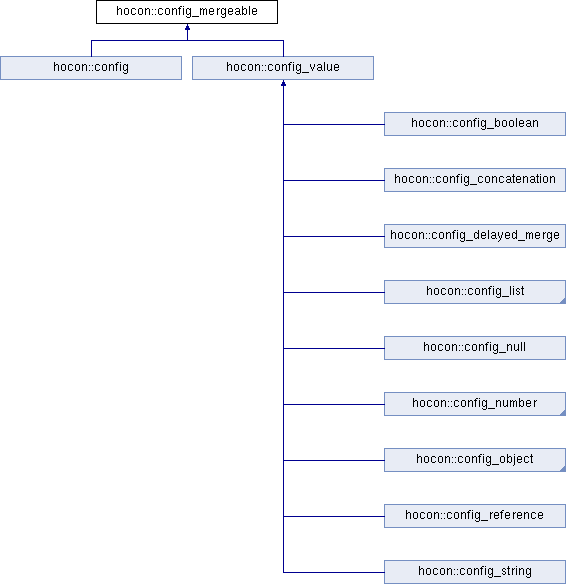
Public Member Functions | |
| virtual std::shared_ptr< const config_mergeable > | with_fallback (std::shared_ptr< const config_mergeable > other) const =0 |
| Returns a new value computed by merging this value with another, with keys in this value "winning" over the other one. More... | |
Protected Member Functions | |
| virtual shared_value | to_fallback_value () const =0 |
| Converts a config to its root object and a config_value to itself. More... | |
Friends | |
| class | config_value |
Detailed Description
Definition at line 8 of file config_mergeable.hpp.
Member Function Documentation
◆ to_fallback_value()
|
protectedpure virtual |
Converts a config to its root object and a config_value to itself.
Originally in the MergeableValue interface, squashing to ease C++ public API separation
Implemented in hocon::config, and hocon::config_value.
◆ with_fallback()
|
pure virtual |
Returns a new value computed by merging this value with another, with keys in this value "winning" over the other one.
This associative operation may be used to combine configurations from multiple sources (such as multiple configuration files).
The semantics of merging are described in the spec for HOCON. Merging typically occurs when either the same object is created twice in the same file, or two config files are both loaded. For example:
foo = { a: 42 }
foo = { b: 43 }
Here, the two objects are merged as if you had written:
foo = { a: 42, b: 43 }
Only config_object and config instances do anything in this method (they need to merge the fallback keys into themselves). All other values just return the original value, since they automatically override any fallback. This means that objects do not merge "across" non-objects; if you write object.withFallback(nonObject).withFallback(otherObject), then otherObject will simply be ignored. This is an intentional part of how merging works, because non-objects such as strings and integers replace (rather than merging with) any prior value:
foo = { a: 42 }
foo = 10
Here, the number 10 "wins" and the value of foo would be simply 10. Again, for details see the spec.
- Parameters
-
other an object whose keys should be used as fallbacks, if the keys are not present in this one
- Returns
- a new object (or the original one, if the fallback doesn't get used)
Implemented in hocon::config, and hocon::config_value.
The documentation for this class was generated from the following file:
- hocon/config_mergeable.hpp
 1.8.18
1.8.18